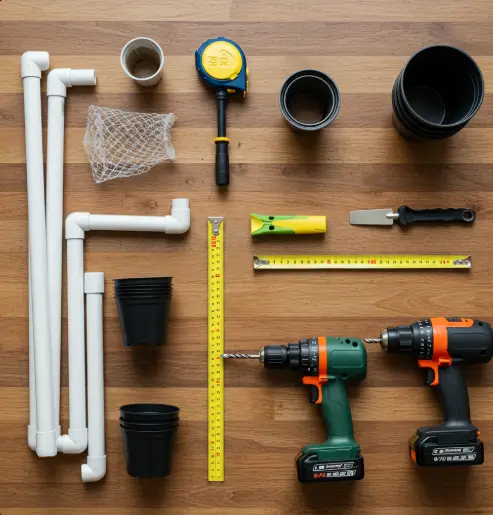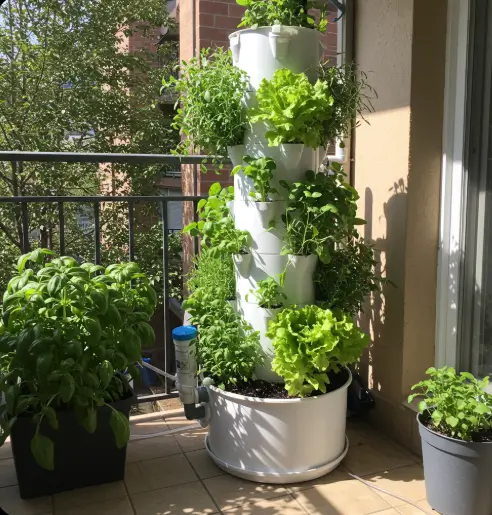Introduction to DIY Tower Gardening
I remember visiting my neighbor Doña Rosa, a kind woman from Oaxaca, who showed me how she grew cilantro, spinach, and basil on her tiny apartment balcony. “No necesito mucho espacio,” she told me with a smile, meaning, “I do not need much space.” She had stacked reused soda bottles vertically and made what I would later discover was a basic tower garden. That experience sparked my interest in building my own — especially because my apartment patio barely fits two chairs.
Tower gardening is a method of growing multiple plants in a vertical system, ideal for those with limited space. Most use hydroponic or aeroponic systems, meaning the plants grow without traditional soil. Instead, water and nutrients circulate to nourish the roots.
The benefits are impressive:
- Space-efficient vertical design
- Reduced water usage
- Customizable to any space
- No weeding required
If you are short on yard space but big on green dreams, keep reading.
Table of Contents
Planning Your DIY Tower Garden
Before starting construction, the first step is planning. Look around your home—do you have a sunny patio corner, a south-facing window, or a small balcony? Measure that space. You will need at least two feet in diameter and vertical clearance, ideally about 4 to 5 feet.
Next, consider your light source. Most plants require at least 6 hours of sunlight daily. If sunlight is limited, supplement with full-spectrum grow lights.
Then, opt for how many plants you want to grow. A small DIY tower garden can hold 12 to 20 plants, depending on your design. I recommend starting small—one or two tiers—to get the hang of it.

Choose between hydroponic and aeroponic methods. Hydroponic is simpler for beginners, using a basic water reservoir and pump. Aeroponics is more advanced and uses mist for nutrient delivery.
Think about:
- Indoor vs. outdoor location
- Water access
- Power supply (for a pump)
Planning makes building and maintaining your tower garden smoother.
Materials and Tools You’ll Need
There’s no need to spend hundreds of dollars. You may already have many of the DIY tower garden materials at home or your local hardware store. Here’s what I used for my first build:
Essential Materials
- 4″ or 6″ diameter PVC pipe (3–5 feet tall)
- 5-gallon bucket (as the base and reservoir)
- Net pots (2″ or 3″)
- Submersible water pump (80–160 GPH)
- Flexible tubing (¼ inch)
- Growing medium: rockwool, coco coir, or hydroton clay pebbles
- Food-safe sealant
Basic Tools
- Power drill
- Hole saw bit (for net pots)
- Hacksaw or PVC cutter
- Ruler or measuring tape
- Sandpaper
- Protective gloves and eye goggles
Pro Tip: Try sourcing PVC off-cuts from construction sites or reusing buckets from local food stores to save money and reduce waste.
Safety first: Always wear gloves and goggles when cutting and drilling.

Step-by-Step Construction Guide
Now for the fun part—let’s build your DIY tower garden. Set aside 2–3 hours for the project.
Step 1: Cut and Prep Your PVC Pipe
Mark your PVC pipe at intervals based on your plant spacing. I recommend spacing the holes at least 6 inches apart vertically and alternating sides to allow airflow.
Cut the pipe to your desired height—3 to 5 feet works well. Sand down the edges for a clean, safe finish.
Step 2: Drill Holes for Net Pots
Using a hole saw bit, drill circular openings for your net pots. Make sure the size matches the pots snugly so they don’t fall through. After drilling, sand around each hole.
Step 3: Assemble the Base
Insert the PVC pipe vertically into the 5-gallon bucket and seal around the edges with food-safe silicone. This forms your tower’s base and nutrient reservoir.
Step 4: Install the Water System
Place the submersible pump into the bucket and connect the tubing. Run the tube up through the center of the pipe to the top. Drill a small hole at the top for water flow and secure the tube.
Set the timer on the pump to run 15 minutes every hour (adjust based on plant needs).
Step 5: Add the Growing Medium
Place the growing medium inside each net pot, insert your seedlings or seeds, and slot them into the drilled holes.
Once assembled, fill the bucket with a hydroponic nutrient solution, plug in your pump, and voilà—your tower garden is alive!

Best Plants to Grow in a DIY Tower Garden
Tower gardens are best for lightweight, fast-growing plants. Here are some top picks:
Ideal Plants
- Lettuce (butterhead, romaine)
- Kale
- Spinach
- Swiss chard
- Basil
- Cilantro
- Mint
- Strawberries (compact varieties)
Avoid These Plants
- Carrots
- Onions
- Potatoes
- Large vining squash or tomatoes, unless supported externally
Stick to herbs and greens initially—they are forgiving and quick to harvest.
Maintenance Tips
Maintaining your DIY tower garden is simple if you check it daily.
Water and Nutrients
- Check water level every 2–3 days
- Monitor pH (keep it between 5.5 and 6.5)
- Refill nutrients weekly or biweekly
Cleaning and Pest Control
- Rinse pump tubing monthly
- Use neem oil spray or insecticidal soap for pests
- Keep the area clean and inspect roots regularly
Consistent monitoring ensures healthy plants and high yields.
FAQs – DIY Tower Gardening Basics
What can you not grow in a DIY Tower Garden?
Avoid deep-rooted vegetables like carrots and potatoes—they need more space.
What is the easiest DIY hydroponics system?
The Deep Water Culture (DWC) method is simple, involving a bucket and air stone.
How to make a PVC grow tower?
Use a vertical PVC pipe, drill holes, insert net pots, and set up a pump for water flow.
How many plants can you grow in one tower?
A 4-foot tower can hold 16–20 small plants, depending on spacing and pot size.
Recap
DIY tower gardening offers an innovative and affordable way to grow fresh food in tight spaces. You can transform a patio or balcony into a productive garden with minimal tools and effort . Start small, stay curious, and enjoy the rewards of homegrown greens. (Click here to see more.)
Disclaimer
This content is for informational purposes only and does not constitute medical or professional gardening advice. Please consult a professional before making any changes to your health, diet, or property.
